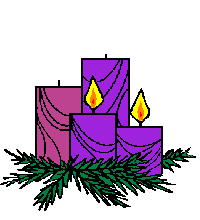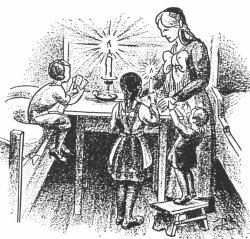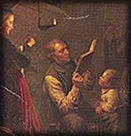 Christmas is coming.
Christmas is coming. And we are already running race against time in the Advent. The first candle in the Advent wreath has already been lit, the Candle of the Prophet, and we are about to lit the second one, the Bethlehem Candle. People are already decorating their homes, outside to start with, the house itself and one or more trees in the yard, but pretty soon decorating inside will be part of the preparations for Christmas, along with baking and . . . shopping, shopping and shopping. We have to remember all the presents. Those who don't get any present are taken by the Christmas cat! (see further below.) We are happy to give, we are happy to receive and most happy of all are the dealers and shopkeepers.
Your grandparents or great grandparents who emigrated before or around 1900 didn't live in such a rush as we do today. Gubj÷rg Jˇnsdˇttir (settler of the week) emigrated with her husband Ëlafur Jˇhannsson in 1887 from the county of Skagafj÷rur where they had been farming, yes, born and raised. Gubj÷rg had six children with four men. One of her children, Gubj÷rg SigrÝur Bj÷rnsdˇttir had pleasant memories of her childhood in Iceland, which she shared in reminiscences published in a Christmas newsletter. It describes celebrations, food, and home activities that were common to all Icelanders of the time.

|
Christmas Eve.
Drawing 1932 by Tryggvi Magn˙sson.
|
|
"
I remember Christmas in Iceland. There were no Christmas trees at the time, but a great many candles were used, made of mutton tallow. Elaborate ones were made for the churches - three candles in a candelabrum signi- fied the wise men from the East.
The baking was extensive; doughnuts and round balls were fried in mutton tallow. Rye bread, which took hours to bake, was given to each child. Pan- cakes, wafer thin, were also a delicacy. They were sprinkled with sugar and then rolled up. They made Jola Cake (Christmas cake) and Vinarterta. The Vinarterta is Iceland's national cake. It is made of several layers of rich cookie dough with prune filling.
On Christmas Eve, the family sang hymns and the Christmas story was read. The gifts were given out, and then supper was served, and how the coffee flowed! The children were given hot chocolate. Christmas Day was a continuation of the celebration. After dinner the family went to church. It was called
Hˇlar in Hjaltadal. This was one of the oldest and most famous churches in Iceland. It was built in the sixteenth century of red sandstone and had been painted white. The stones were taken from a mountain a mile away. The last bishop who lived there was the famous, but ill-fated, Jon Arason, who was killed in Skalholt by servants of the Danish Government. He was the last Catholic bishop who lived in Iceland.

At Hˇlar were two large houses, a few hundred yards apart. The larger was called
The Netherland, which had the college taught by priests and learned men. The smaller house where my folks lived was called
New House. Each house had a drawing room used for parties and receptions.
We children used to ski, toboggan, and skate a lot in winter. There is no sunshine in Northern Iceland in December and the first part of January. In the long winter evenings, a reader would sit in the center of the big room and read stories and poetry. The sagas were universal favorites. The reader also read books that had been translated from English or Danish. This shortened the time, as it was dark at three thirty in the afternoon. During the reading, the children knitted, the women spun wool, sewed, or mended, and the men carded wool. One man wove on a big loom. Hymn singing was enjoyed every evening, and one person would read an extract from the Bible."
